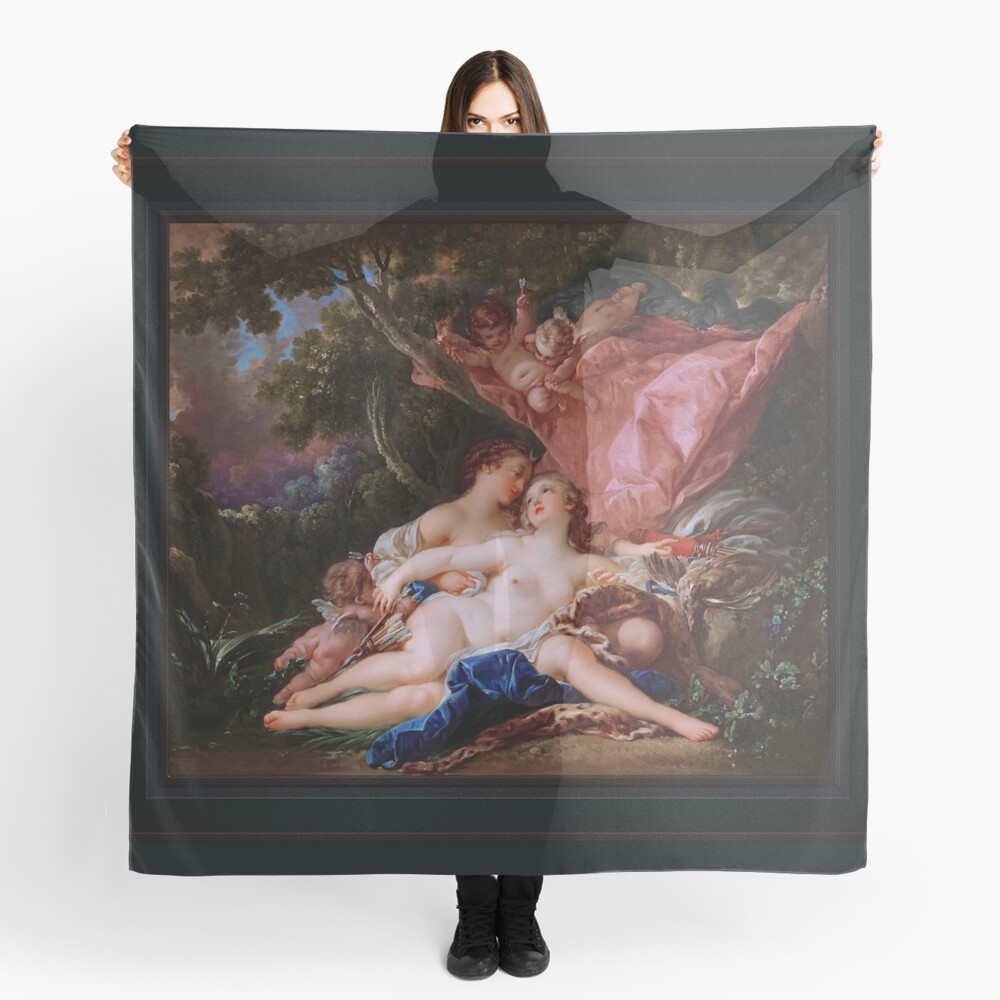
Júpítà nínú Ẹ̀rí Diana, and the Nymph Callisto
Júpítà nínú Ẹ̀rí Diana, and the Nymph Callisto c1759 by French Painter Francois Boucher (1703 – 1770); also known as a draftsman, engraver and decorator in the French Rococo style, that was well known for his lavish mythological, allegorical and erotic motifs and was the court painter of Louis XV and a favorite of the Marquise de Pompadour.

This is a beautiful scene depicting the characters from Roman mythology Jupiter (The Eagle), Diana (Goddess of the Hunt), and Callisto the favorite Nymph of Diana.
In this forest scene we can see six figures, two cherubs in a tree with a large rose drape hanging from one of its outstretched limbs, near the eagle Jupiter looking down on what appears to be Diana and her Nymph Callisto, with one holding an arrow in his left hand; with another on the ground by the pond that Diana and her Nymph Callisto are laying near with an arrow in its left hand and a quiver filled with arrows by its right side.
Jupiter, the King of the Gods taken by the beauty of Callisto, disguises himself as the huntress Diana to seduce her; embracing her while they relax by the pond on a cushion of leaves, a blue garment and leopard skin.
By the couple is a boulder that has on it a brown bird resting on the chest of light colored bird that has had its throat cut, with blood staining the rock.
Behind the birds is a red quiver filled with arrows and a bow and another wrapped up grey colored garment, that rest just under the pink drape and the eagle Jupiter.

In the background is a colorful forest of many different hues and a light blue sky filled with many colored clouds, that seems to be illuminated by a setting sun.
Júpítà nínú Ẹ̀rí Diana, and the Nymph Callisto is a remastered digital art old masters reproduction of a public domain image that is available as a kanfasi tẹjade lori ayelujara.
Alaye ni isalẹ yo Lati Wikipedia.org
Ilu abinibi ti Paris, Boucher jẹ ọmọ ti oluyaworan ti a ko mọ diẹ sii Nicolas Boucher, ẹniti o fun u ni ikẹkọ iṣẹ ọna akọkọ rẹ. Ni awọn ọjọ ori ti mẹtadilogun, aworan kan nipasẹ Boucher jẹ iwunilori nipasẹ oluyaworan François Lemoyne. Lemoyne nigbamii yàn Boucher gẹgẹ bi ọmọ-iwe rẹ, ṣugbọn lẹhin osu mẹta nikan, o lọ lati sise fun awọn engraver Jean-François Cars.
Ninu 1720, o gba Gbajumo Grand Prix de Rome fun kikun, ṣugbọn ko gba aye ti o wulo lati kawe ni Ilu Italia titi di ọdun marun lẹhinna, nitori awọn iṣoro owo ni Royal Academy of Painting and Sculpture.[1] Ni ipadabọ lati ikẹkọ ni Ilu Italia o gba wọle si Académie de peinture et de sculpture ti o tun ṣe. 24 Oṣu kọkanla 1731. Nkan gbigba rẹ (gbigba nkan) je rẹ Rinaldo ati Armida ti 1734.

Boucher ni iyawo Marie-Jeanne Buzeau ni 1733. Tọkọtaya náà bí ọmọ mẹ́ta pa pọ̀. Boucher di omo egbe Oluko ni 1734 ati pe iṣẹ rẹ yara lati aaye yii bi o ti ni igbega Ọjọgbọn lẹhinna Rector ti Ile-ẹkọ giga, di olubẹwo ni Royal Gobelins Manufactory ati nipari Premier Peintre du Roi (First Oluyaworan ti Ọba) ninu 1765. Aworan ti Marie-Louise O'Murphy c. 1752
Boucher ku lori 30 May 1770 ni ilu abinibi re Paris. Oruko re, pẹlu ti olutọju rẹ Madame de Pompadour, ti di bakannaa pẹlu aṣa Rococo Faranse, asiwaju awọn arakunrin Goncourt lati kọ: “Boucher jẹ ọkan ninu awọn ọkunrin ti o ṣe aṣoju itọwo ti ọgọrun ọdun, ti o han, eniyan ati ki o embody o.”
Boucher jẹ olokiki fun sisọ pe iseda jẹ “ju alawọ ewe ati ibi tan” (ju alawọ ewe ati koṣe tan).
Boucher ni nkan ṣe pẹlu gemstone engraver Jacques Guay, ẹniti o kọ lati fa. O tun ṣe iyanju oluyaworan ara ilu Moravian-Austrian Martin Ferdinand Quadal bakanna bi oluyaworan neoclassical Jacques-Louis David ni 1767.[4] Nigbamii, Boucher ṣe lẹsẹsẹ awọn iyaworan ti awọn iṣẹ nipasẹ Guay eyiti Madame de Pompadour lẹhinna kọwe ati pinpin bi iwọn didun ti o wuyi si awọn agbala ti o nifẹ si.



